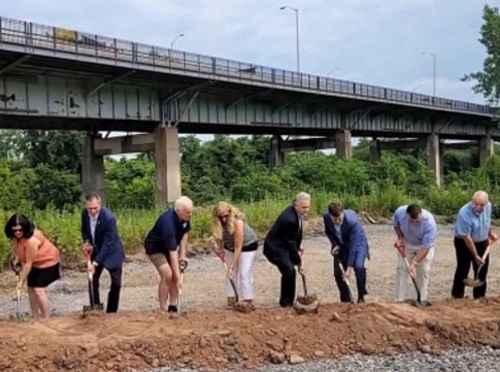The Connecticut Department of Transportation, along with other state and local officials, recently hosted a groundbreaking ceremony (seen above) for the Putnam Bridge Trail Connections between Wethersfield and Glastonbury across the Connecticut River.
[Above photo by the Connecticut DOT]
When completed in the fall of 2023, the Putnam Bridge Trail Connections project will provide non-motorized access across the Connecticut River by linking the shared used path on the Putnam Bridge to Great Meadow Road in Wethersfield and Naubuc Avenue in Glastonbury.
The project will also install sidewalks will also be installed on both sides of Naubuc Avenue, with additional connections planned for the Goodwin College trails in East Hartford.
“Finishing the current gaps to the bridge allows the public to choose an active mode of transportation and safely cross the river. When completed, residents and visitors can enjoy the businesses and recreational activities on both sides of the river,” said Connecticut DOT Commissioner Joe Giulietti in a statement.
“The Putnam Bridge brings vehicles over the Connecticut River between Wethersfield and Glastonbury, and by the end of next year, it will also be accessible to pedestrians and cyclists,” he added. “This is a great project that connects communities and helps keep pedestrians and bicyclists safe.”
[Editor’s note: Connecticut DOT’s Giulietti recently received the Distinguished Service Award from the American Public Transportation Association for his 50-plus years of service in the transportation industry. He is one of nine APTA award recipients in 2022 across various categories.]
The agency noted that construction costs for the Putnam Bridge Trail Connections project are approximately $8.2 million and are 100 percent state funded.
State departments of transportation across the country are involved in similar active transportation trail projects.
For example, the Nevada Department of Transportation recently hosted an opening ceremony for a new multi-use trail at Kershaw-Ryan State Park in Caliente, NV.
That $1.36 million project along SR-317 – which took under four months to complete – received funds from the city of Caliente with matching federal dollars from the Transportation Alternatives Fund administered by the Nevada DOT, which also designed the trail project. Work included a chip seal, restripe, and new signage on Clover St. from SR-317 to Depot Ave.
“Nevada DOT really went the extra mile, both literally and figuratively,” said Jeff Fontaine, executive director of the Lincoln County Regional Development Authority, said in a statement. “They worked really hard to make sure that this project was something the community of Lincoln County and the city could afford. They capped the cost of the project for the county and the city.”
Meanwhile, a team of Utah State University researchers recently explored how to use the state’s network of historic canal trails as an active transportation solution. That study is poised to help the Utah Department of Transportation and community leaders make decisions about building canal paths and trails.
The Utah DOT funded the university’s research project – entitled “Active Transportation Facilities in Canal Corridors” – that the American Society of Civil Engineers subsequently published in June.
By reviewing case studies of existing canal trails – such as the Murdock Canal Trail in Utah County and the Highline Trail in Cache County – and interviewing stakeholders like canal operators and local planners, the USU team found there are many potential benefits for communities who want to build canal paths and trails.

